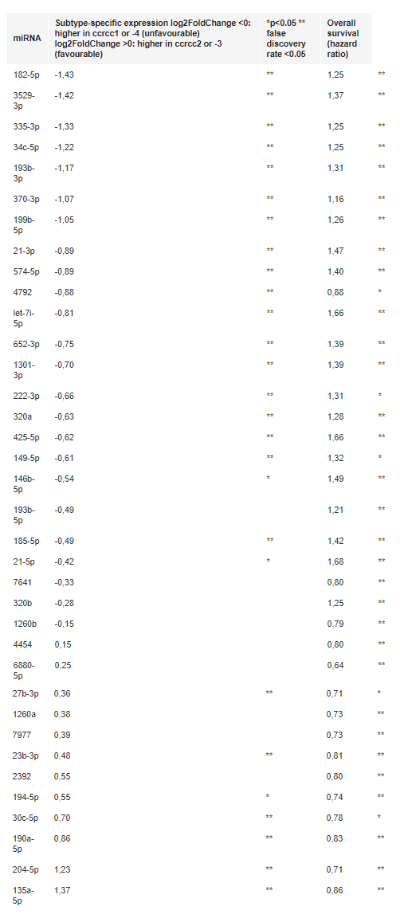Background
Based on mRNA expression, accRCC can be divided in four molecular subtypes (ccrcc1-4), associated with prognosis, angiogenic signature, immune phenotype and therapy response. miRNAs are master regulators of mRNA function. We assessed the correlation of miRNA expression with (1) ccrccc1-4 subtypes, (2) mRNA targets and (3) outcome.
Methods
We performed miRNome analysis of 128 accRCC. (1) Unsupervised hierarchical clustering was done using 50 miRNAs with the most variable expression across all samples. Results were validated on TCGA data (n = 255). (2) For miRNAs with subtype-specific expression, we performed pathway analysis of predicted mRNA targets (IPA, KEGG) and assessed target-downregulation in TCGA. (3) We used Cox regression to correlate miRNA expression with overall survival (OS) since diagnosis. Hazard ratios (HR) were correlated with subtype-specific expression (Pearson).
Results
(1) Samples separated in two miRNA clusters, that partially overlapped with molecular subtypes. Cluster 1 consisted of 69% favourable subtypes (ccrcc2 or 3), cluster 2 of 77% unfavourable (ccrcc1 or 4) (p < 2.2e-16). (2) Pathway analysis of predicted mRNA targets and targets suppressed in TCGA, suggested that favourable subtypes exhibit more angiogenic signaling, whereas unfavourable subtypes activate pathways involved in tumor invasiveness. (3) Several miRNAs were significantly associated with OS. There was a robust correlation in the entire dataset between HR for OS and differential expression between favourable/unfavourable subtypes (r = 0.322; p < 0.0001).Table:
973P

Conclusions
accRCC molecular subtypes exhibit different miRNA expression patterns. Differentially expressed miRNAs are implicated in pathways driving tumor biology and strongly correlated with OS. These findings underscore the robustness of the molecular subtypes and are, to the best of our knowledge, the first to show an association of global miRNome expression with outcome.